California Community College Students Transformed by Makerspaces
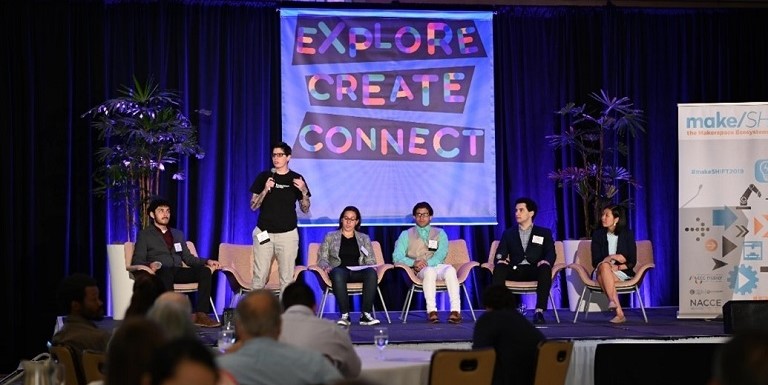
Sacramento City College student and entrepreneur Christian Espinoza’s personal essay was published in Makerspace Impact: Implementation Strategies & Stores of Transformation: “At the time, it was all I ever wanted—to create things that were unbelievable and out of this world,” wrote Espinoza, who exemplifies thousands of students whose lives have been transformed by the CCC Maker initiative. He continued,
But as I grew up, those dreams felt more and more unachievable. I thought I could only work a standard job with a fixed pay and maybe benefits, which didn’t sound half bad. I assumed that my days of starting my own business and chasing my dreams were far behind me. That is, until I discovered the Sacramento City College (SCC) Makerspace, which—little did I know—would touch my deepest childhood memories and actually make my dreams become a reality.
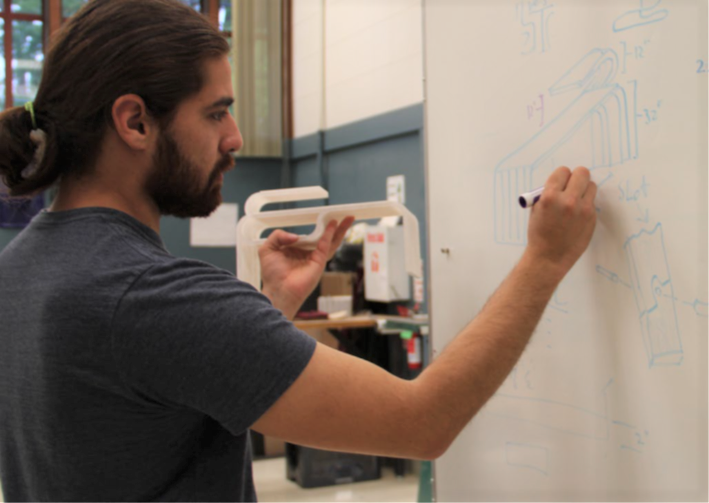
Christian Espinoza, Sacramento City College student and entrepreneur, develops
designs for furniture he made on the CNC tools at Sacramento City College.
Just as Espinoza finished making a simple three-piece wooden table while learning to use the makerspace’s Computer Numerical Control (CNC) machining tool, he met an entrepreneur who commissioned him to design and build furniture for her hair and nail salon. “As I worked on the order day after day, I had a sudden moment of realization that, ‘Oh my god, this is it,’” wrote Espinoza. He was realizing his “dreams of becoming a designer and having the skills and knowledge” necessary to own his own business.
The Sacramento City College makerspace gave Espinoza the confidence, skills, and innovation mindset to launch his entrepreneurial career. “Had it not been for the makerspace, the CNC machine that I use in my designs, or my ability to say ‘yes’ even when the odds seem difficult, I wouldn’t be where I am today,” he said. “The energy that makerspaces give an individual like me—to make the wildest dreams or theoretical ideas come to life—is what gives those ideas purpose and a chance to make them something the world can use every day.”
Statewide Makerspace Network Achieved Goals
The CCC Maker initiative that funded the startup of makerspace communities at Sacramento City College and 23 other California Community Colleges has left a legacy of resources for other colleges. Funded by the California Community College Chancellor’s Office, Workforce and Economic Development Division, the network of college makerspaces was successful in fostering students’ innovation skills, preparing them for in-demand jobs, launching student-driven entrepreneurial ventures, and sparking an interest in science, technology, engineering, art, and mathematics (STEM/STEAM) careers.
From the start, the initiative encouraged colleges to focus on building community, especially among students, rather than makerspace tools and equipment, explained Carol Pepper-Kittredge, Statewide CCC Maker Director and Associate Dean of Workforce Innovation, Sierra College. “The students are the heart of the makerspaces, and, in turn, the maker community supported and transformed students’ lives,” said Pepper-Kittredge. “In the final year, we deliberately shined the light on students as presenters at the Bay Area Maker Faire and make/SHIFT conference, cosponsored with the National Association for Community College Entrepreneurship. The students were also featured in videos and publications.”
Part of the proof of concept over the nearly three years of funding was to collect data that would support makerspace sustainability as well as help other colleges. The metrics collected included:
- Student impact - number of students who used the makerspaces, badges earned, and average time spent in the spaces
- Community - number of partners in the ecosystems and amount of matching funds
- Industry partners - number of employers recruited, advisory meetings held, and funded internships completed
- Curriculum - number of faculty members involved and professional development activities
The final results of the project showed that over 64,000 students were impacted by the CCC Maker initiative. “Each college developed a unique makerspace community that cumulatively engaged 691 faculty members, funded 844 internships, and recruited over 1,296 employers statewide,” said Pepper-Kittredge. “Through hands-on learning experiences with cutting-edge technology within a creative community supported by the broader ecosystem, students in California Community Colleges emerged from makerspaces with skills sought by growing industries.”
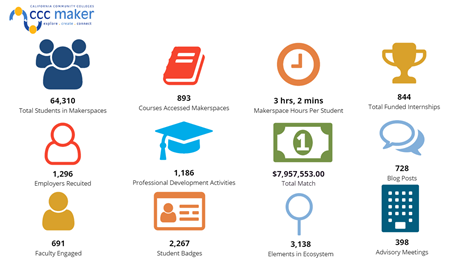
CCC Maker colleges tracked metrics and made quarterly reports that were posted in real time on the initiative website.
Makerspace Leaders Supported Network Development
The initiative benefited from an advisory committee led by Dale Dougherty, President, Make Community, Founder, MAKE magazine, and creator, Maker Faire. “We have a world with abundant technology, but it takes talented people to solve problems that make a difference for society and individuals,” said Dougherty. “Community colleges are open to the broadest spectrum of students with the raw talent, and the maker movement is the great leveler, providing a supportive environment for students to use tools, develop skills, and solve problems.”
The advisors included industry partners from Adobe, Hacker Lab, Intel®, Kiva, Northrop Grumman, and VSP Global® as well as educators and representatives from California Asian Chamber of Commerce, California Council of Science & Technology, CCCCO Workforce and Economic Development Division, Folsom Lake College, Foundation for California Community Colleges, the Governor's Office of Economic Development, Maker Ed, National Association for Community College Entrepreneurship, New World of Work, and Yuba College.
The Sierra College Joint Community College District, which established the first community college public/private makerspace partnership in the nation, administered the initiative and served as fiscal agent. “We’ve seen tremendous impact from having a makerspace affiliated with the college,” said Willy Duncan, President, Sierra College Joint Community College District. “Integrating community colleges with the maker community inspires innovation, prepares students as entrepreneurs or for in-demand jobs, and boosts our economy.”
Scaled Approach to Work-Based Experiences
The CCC Maker initiative advisory committee envisioned that college makerspaces could become solution centers for industry partners seeking students’ skills to solve business problems. Combining this idea with the goal of colleges delivering over 800 internships, CCC Maker developed Makermatic, a makerspace-based team internship where students could develop real-world business solutions.
With Makermatic, the initiative reimagined the way that college-based internships are typically structured. Rather than the traditional one-on-one internship model, Makermatic is a paid seven-session, 20-hour internship for up to 25 students where a business leader presents a real problem and teams of four to five students ideate, prototype, and present viable solutions to the business partner. The Makermatic program was piloted at five colleges and resulted in two publications available on the CCC Maker website: Makermatic: A Scalable Approach to Team Internships and Makermatic Workbook for Coaches.
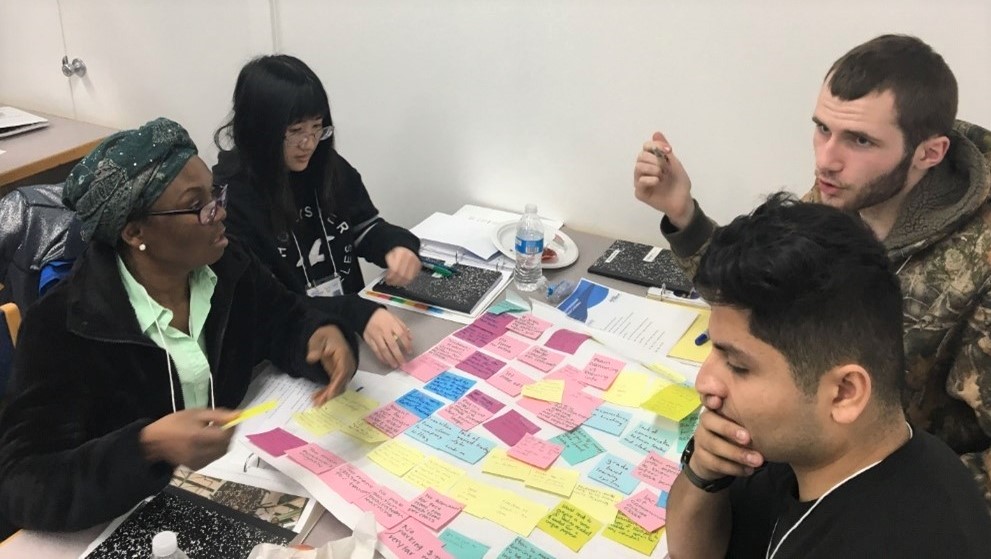
Sierra College students participate in Makermatic team internship brainstorming exercise.
Unique College Makerspace Communities
From the start, the initiative encouraged colleges to create makerspaces that reflected their unique local ecosystems, so an array of educational makerspace models evolved. Allan Hancock College formed the Central Coast Makerspace Collaborative in Santa Maria with the public library and children’s museum. The college held pop-up makerspaces in the Culinary Arts kitchen, ceramics lab, and campus library to boost awareness of the makerspace collaborative and celebrate different forms of making. College students worked as interns in the community makerspaces teaching people to use equipment and helping with projects. “In academics, people often feel like they can’t make mistakes, and [in the makerspace] we’re actually inviting them to do just that,” said Joanne Britton, Librarian, Santa Maria Public Library.
At Butte College Create Space Maker Lab, faculty members from physics to engineering to art departments require students to incorporate use of the space into their class projects. The makerspace also helps students start businesses, according to Daniel Donnelly, Chair, Digital Art and Design department, and makerspace faculty lead. “We’re trying to get students out into the workforce as quickly as possible, but we also want them to understand that they don’t have to go work for someone else if they don’t want to,” said Donnelly.
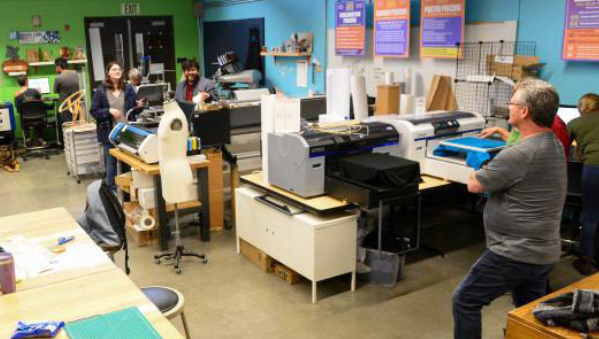
Students enroll in maker class to work on projects for other classes in the Butte College Create Space Maker Lab.
Sierra College, with three campuses spread across a district over 50 miles wide, introduced students and faculty to making by forming partnerships with community makerspaces. Then small maker labs were piloted at the campuses and new curriculum was developed for courses such as math, psychology, and entrepreneurship. Using the Makermatic internship model, students worked with an architect to envision a future on-campus makerspace.
At Cabrillo College, Payson McNett, Art Studio Instructor and Makerspace Director, took the approach of cultivating students as mentors because it offers deep learning for students. “The passing of knowledge is truly the moment when I know my students understand the material fully,” said McNett. "If they can teach somebody else, they know what they're doing."
There are three makerspaces at City College of San Francisco, collectively called the MakerSphere. The college intentionally recruited women to the makerspaces and the Maker 100 classes consistently attracted at least 50 percent female students. “We want the spaces to welcome all students: those who are beginning makers to experienced makers,” said Maura Devlin-Clancy, former Chair, Computer Networking and Information Technology, and MakerSphere Coordinator. “So it was very intentional how we created our spaces to welcome every student from across the campus: male, female, young, old, and across all ethnic groups.”
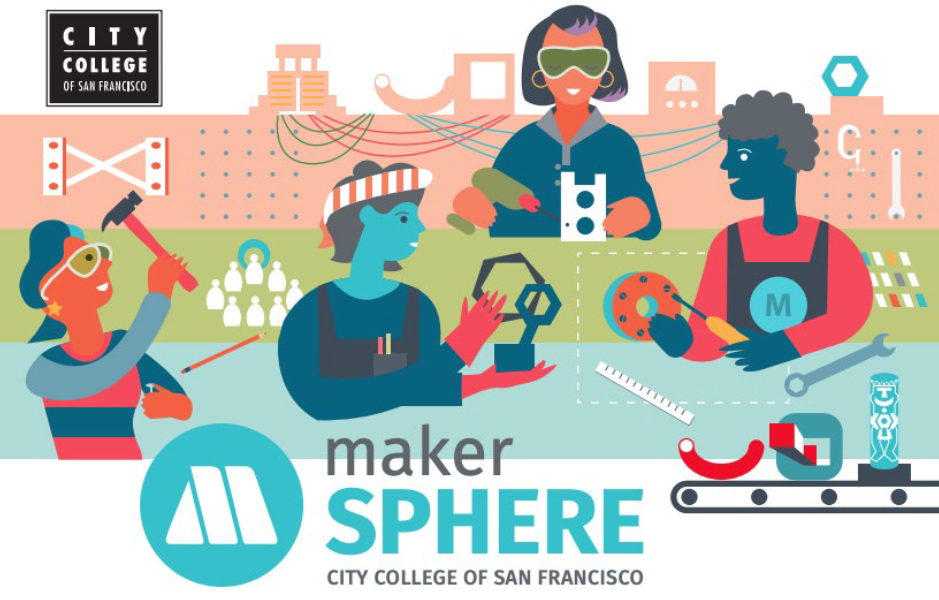
At City College of San Francisco, MakerSphere images, communication, and
events were deliberately designed to engage women in making.
College leaders took risks to establish cross-disciplinary hands-on community spaces with digital tools to close the skills gap, explained Deborah Bird, CCC Maker Technical Assistance Provider and Professor, Architecture, Visual Arts, and Media Studies, Pasadena City College. “The CCC Maker network encouraged participating colleges to lead the way in redefining what it means to be well-educated, especially in terms of a swiftly-changing economy demanding a resilient and adaptable workforce,” said Bird. “Successful faculty leads challenged traditional curricular boundaries and pedagogical practices, built community on and off campus, engaged local employers, and encouraged students to initiate projects across disciplines as well as start entrepreneurial ventures.”
Many more college approaches as well as inspiring student essays are included in Makerspace Impact: Implementation Strategies & Stores of Transformation. To see how college makerspaces adapted to their communities’ needs, watch the videos posted at cccmaker.com/category/videos.
Makerspaces: Lasting Impact
Espinoza reflected on how the makerspace, with its collaborative spirit, access to tools, openness to experimentation, and encouragement, can aid students in approaching their future with an entrepreneurial mindset: “I believe that makerspaces can do the same for all individuals who have dreams of making their unbelievable creations come to life,” he said.
In funding the CCC Maker initiative, the California Community College system foresaw college makerspaces as an innovate approach to providing students like Espinoza with 21st century skills. The unique makerspace environment proved to enable students to collaborate across disciplines, develop digital literacy, hone problem solving skills, and apply critical thinking. Being part of a makerspace community ignited students’ passions, clarified their career plans, and gave them adaptive skills.
According to Dougherty, the lasting impact of CCC Maker will be a generation of students who are prepared to innovate and contribute to society. “We know that young people who get exposed to making and are inspired, lead different lives than those who don’t,” said Dougherty. “In a makerspace, students learn not to live within comfortable boundaries but to take creative risk and try things.”
This issue builds on the January 2019 issue of Innovation Showcase, which introduced the CCC Maker Initiative. Sierra College’s leadership role in developing community college makerspaces was described in the April 2018 issue of Innovation Showcase.
Lead image: Students from CCC Maker colleges describe the impact their college makerspace had on them during make/SHIFT conference.
Karen Fraser-Middleton is President of Marketing Action, Inc. and responsible for Strategic Communication for the California Community Colleges CCC Maker Initiative.
Opinions expressed in Innovation Showcase are those of the author(s) and do not necessarily reflect those of the League for Innovation in the Community College.










